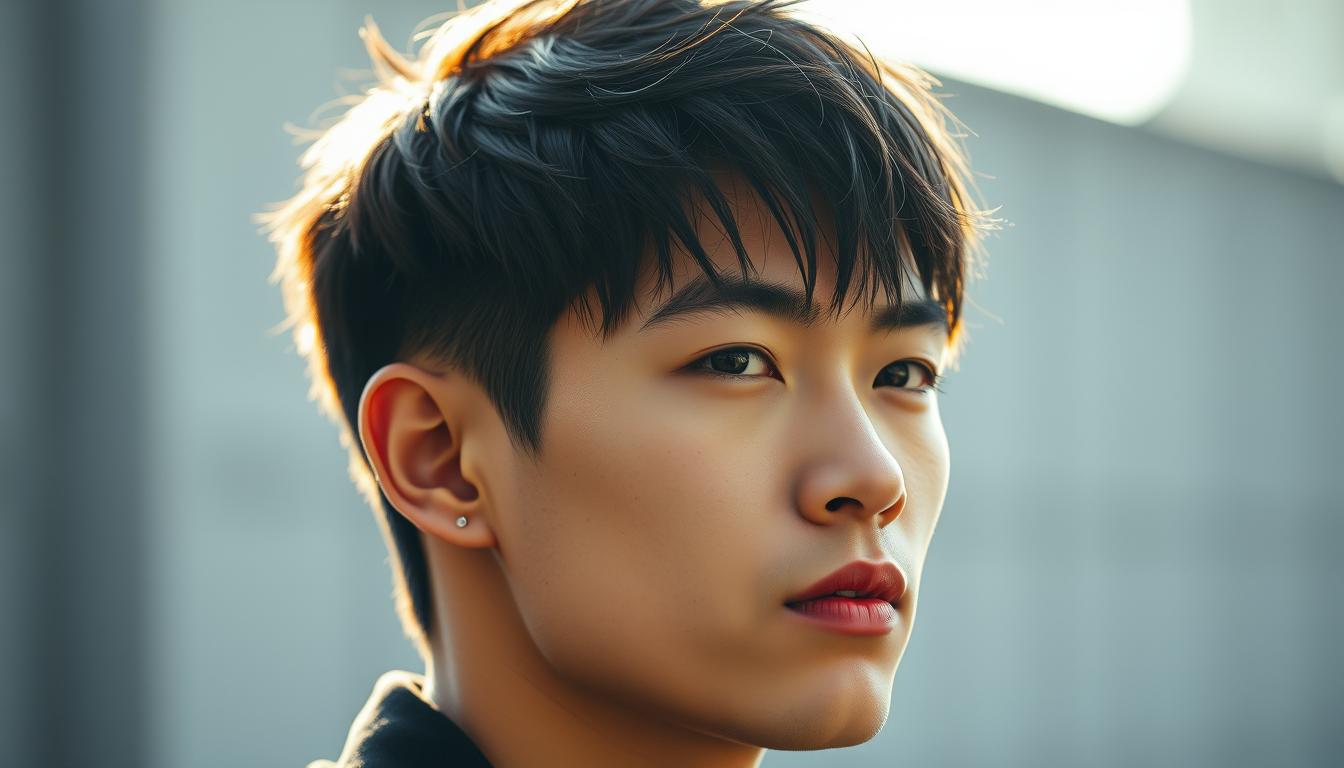
Imagine walking into a room where your hair speaks before you do—bold, textured, and effortlessly cool. This isn’t just a haircut; it’s a cultural movement reshaping grooming standards worldwide. Inspired by 90s grunge and amplified by Korean pop culture, a daring new aesthetic is dominating TikTok feeds and barbershop conversations alike.
Celebrities like BTS’s Jungkook and Stray Kids’ Hyunjin have popularized this edgy blend of shaggy layers and structured volume. It’s more than a trend—it’s a statement that bridges rebellious youth culture with professional adaptability. The secret? A design that naturally complements sharper jawlines and straight hair textures, making it a favorite among individuals seeking a fresh yet wearable look.
Why does this style resonate so deeply? It merges East Asian beauty ideals with Western rock-inspired edge, creating a universal language of confidence. Whether you’re aiming for subtle texture or dramatic flair, this cut adapts to personal preferences while demanding attention.
Key Takeaways
- Blends 90s grunge with modern Korean aesthetics for a universally striking appearance
- Celebrity-endorsed by global icons, fueling its viral social media presence
- Enhances facial structure through strategic layering and volume
- Balances professional polish with creative self-expression
- Low-maintenance styling options for everyday wear
Introduction to the Wolf Cut Phenomenon
Social media’s latest obsession isn’t a dance trend—it’s a hairstyle rewriting style rules. This look combines rebellious energy with polished adaptability, creating waves far beyond barber chairs.
Overview of the Trend
Born from pandemic-era DIY experiments, this choppy layered style resurrects 90s grunge with a modern twist. Its popularity exploded as people swapped salon visits for bathroom scissors, leading to bold reinventions. Platforms like TikTok transformed these home attempts into viral tutorials, with creators showcasing everything from subtle texture to wild volume.
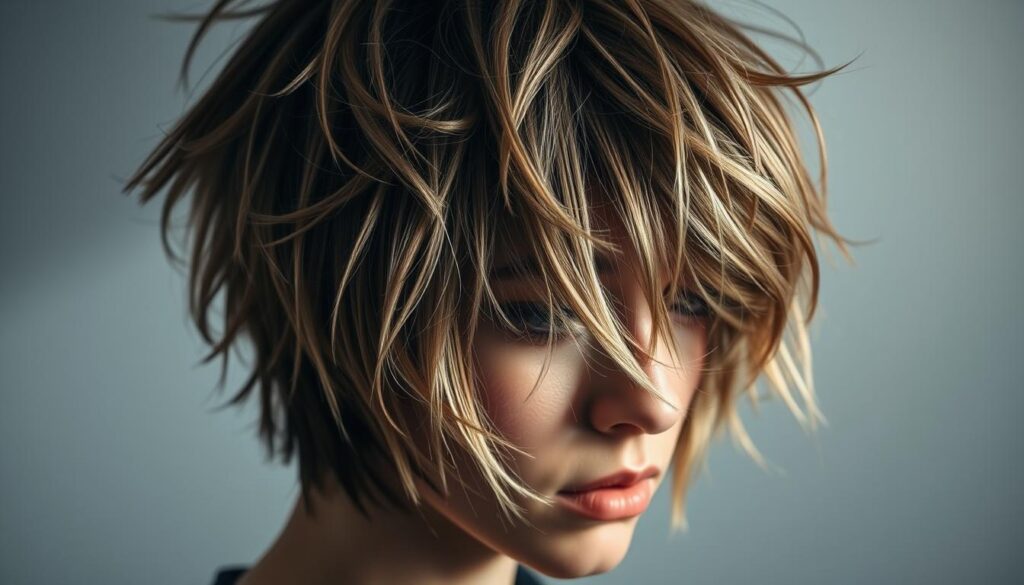
Origins and Cultural Influence
While rooted in Western rock aesthetics, this trend found its true voice through Korean beauty sensibilities. “It’s about balancing edge with elegance,” explains a Seoul-based stylist. The Korean-inspired two-block style provided the foundation, merging sharp angles with soft layers. Global adoption shows how beauty standards evolve—65% of Gen Z now prefer gender-neutral grooming options according to recent surveys.
Celebrity influence accelerated its spread, with music idols demonstrating how the look works both onstage and in boardrooms. This cultural crossover proves style knows no borders when confidence leads the way.
What Is the Wolf Cut?
This bold hairstyle reimagines retro vibes for contemporary wearability. Unlike its predecessors, it blends rebellious energy with meticulous craftsmanship, offering a fresh take on layered looks. The secret lies in balancing raw edge with calculated structure—a formula that works across hair types and lifestyles.
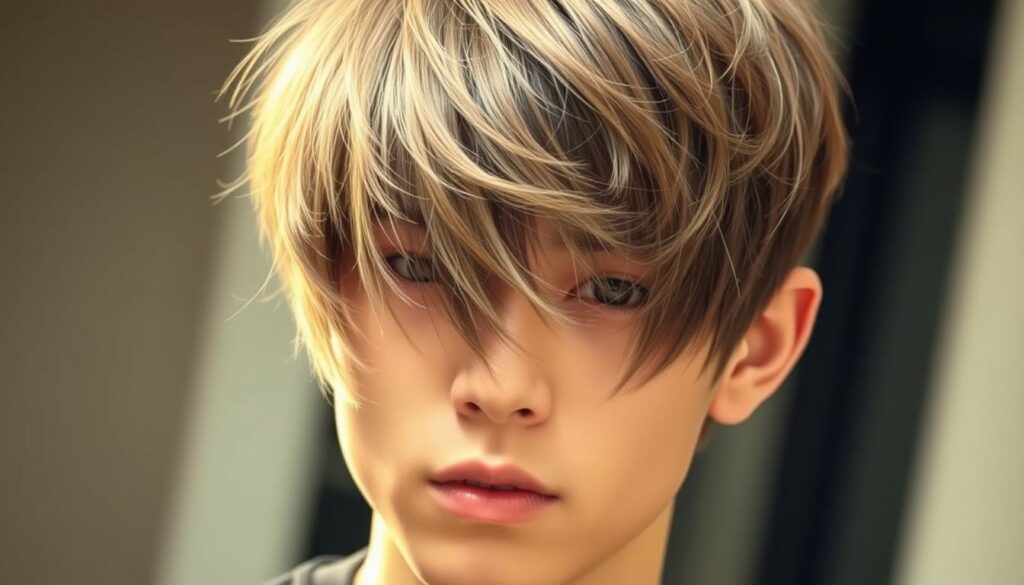
Evolution from Mullet to Modern Style
The modern version builds on the mullet’s DNA but ditches its polarizing extremes. Where classic mullets featured stark contrasts between short sides and long back sections, today’s approach uses graduated layers to soften transitions. This creates flow rather than shock value, making it office-friendly without losing its rock-n-roll soul.
Key Features and Style Elements
Three elements define this look: strategic length variation, intentional texture, and adaptable volume. Crown layers are cut shorter to lift roots, while face-framing pieces cascade toward the jawline. The sides maintain enough weight to balance the top’s fullness, creating harmony across all angles.
Stylists often use point-cutting techniques to enhance natural movement. This eliminates helmet-like stiffness, letting strands fall with artful irregularity. Daily maintenance? A quick tousle with texturizing spray keeps things looking lived-in yet polished.
Why the Wolf Cut Is Perfect for Asian Men
Some hairstyles just click with certain features, creating magic where scissors meet bone structure. This layered phenomenon thrives on thick, straight locks—a common trait that gives the style its signature lift and flow. The secret? Textured ends catch light differently, adding dimension that flat styles can’t match.
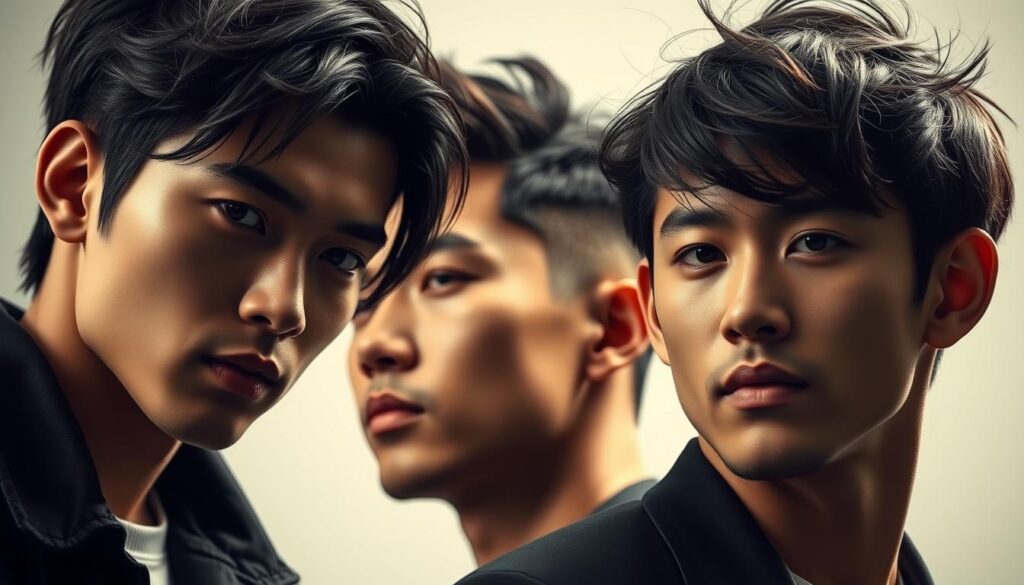
Adapting the Cut for Unique Hair Textures
Dense, straight strands act like natural volumizers when layered. Unlike curly types that might frizz, this hair type holds shape while allowing movement. Stylists often use thinning shears strategically, reducing bulk without sacrificing body. “It’s about enhancing what’s already there,” says LA barber James Kwon. “The right layers turn stubbornly straight hair into a textured masterpiece.”
Enhancing Facial Features and Proportions
Sharp jawlines get softened by face-framing pieces, while narrower faces gain width through crown volume. The style’s graduated lengths draw eyes upward, balancing stronger lower facial features. For rounder shapes, longer front layers create elongation—a trick borrowed from K-beauty contouring principles.
Maintenance stays simple: a dab of wax adds definition, while air-drying preserves natural flow. Whether you’re heading to meetings or concerts, this adaptable look shifts gears faster than a sports car. It’s not just a haircut—it’s geometry working in your favor.
Wolf Cut Asian Men: Style Inspiration & Ideas
Today’s most dynamic looks blend cultural influences with technical precision, creating hairstyles that feel both fresh and intentional. This style evolution thrives on creative experimentation, letting wearers showcase personality through carefully crafted layers and movement.
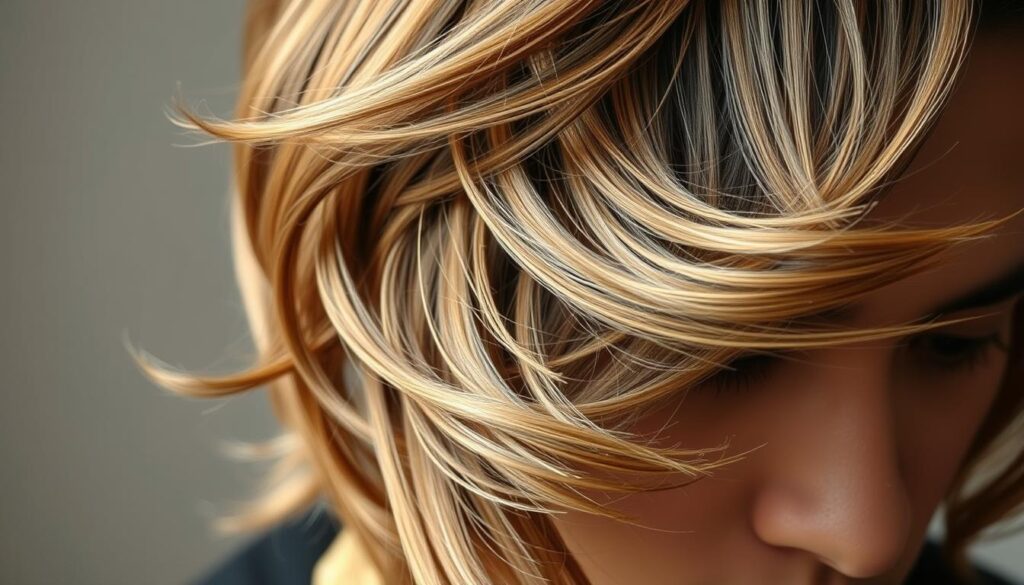
Modern Trends and Influences
Current trends mix K-pop’s bold aesthetics with streetwear’s raw energy. Think asymmetrical bangs paired with gradient tints that shift from espresso black to caramel ends. These choices add depth while keeping maintenance manageable.
Runway-inspired touches like disconnected undercuts or micro-fringe details offer subtle rebellion. Stylists recommend tailoring layer lengths to face shape—longer pieces soften angular jaws, while shorter crown layers amplify volume for rounder faces.
Volume and Texture Techniques
Mastering volume starts with strategic cutting. Point-cutting removes bulk while preserving natural thickness, ideal for straight locks. Slide-cutting creates feathery ends that catch light, enhancing dimension without frizz.
For lasting lift, stylists use round brushes during blowouts, directing airflow upward at the roots. A pea-sized amount of sea salt spray adds grit-free texture. The goal? Effortless body that lasts from morning meetings to late-night hangs.
| Technique | Purpose | Best For |
|---|---|---|
| Point Cutting | Adds movement | Thick hair types |
| Slide Cutting | Reduces weight | Fine textures |
| Razor Work | Creates edge | Choppy finishes |
| Blow-Drying | Lifts roots | All lengths |
Types of Wolf Cut Hairstyles to Experiment With
Barbershops are buzzing with creative variations of this layered phenomenon. From subtle texture to head-turning drama, these styles prove personalization is key. Whether you prefer minimalist edge or bold experimentation, there’s a version that aligns with your vibe.
Classic Layered Look
The signature style rocks short, choppy bangs that frame the forehead. Layers graduate from crown to nape, creating balanced volume. It’s ideal for those wanting structure without stiffness—think “I woke up like this” energy with professional polish.
Center-Part Redesign
Swap blunt fringe for longer face-framing pieces split down the middle. This version softens angular features while maintaining the style’s rebellious roots. Pro tip: Use a light-hold pomade to keep strands in place without flattening movement.
| Style | Key Feature | Maintenance Level |
|---|---|---|
| Permed Texture | Bouncy curls add volume | Medium |
| Wavy Finish | Effortless messy texture | Low |
| Bowl Shape | Youthful, wispy layers | High |
| S-Shaped Flow | Feathered movement | Medium |
For daring personalities, buzzed sides create striking contrast against a textured top. Color enthusiasts can experiment with ombre effects or bold hues. The secret? Matching the length and layers to your hair’s natural behavior.
Celebrity Influence: From K-pop to American Icons
Global music stages have become unexpected runways for hair innovation. What began as a niche Korean trend now dominates red carpets and concert venues worldwide. This cultural bridge proves style speaks louder than language barriers.
K-pop Trendsetters
BTS’s Jungkook transformed textured layers into a global signature. His ever-changing looks—from tousled caramel waves to platinum fringe—demonstrate how one style adapts across seasons. Fans replicate his techniques using sea salt sprays and matte clays.
Stray Kids’ Hyunjin masters silhouette versatility. He pairs face-framing pieces with cropped sides, proving the look works for oval and square jawlines alike. His styling shifts from sleek award-show finishes to messy bedhead textures within hours.
Western Adaptations
Hollywood’s take blends edgy layers with classic grooming. Stars add subtle highlights or combine choppy tops with faded undercuts. This fusion respects the original’s spirit while catering to Western preferences.
Social media fuels cross-continental inspiration. TikTok creators analyze TXT’s Beomgyu’s cobalt-tipped strands alongside Timothée Chalamet’s softer iterations. The result? A style playbook that evolves faster than fashion week trends.
Red carpets now showcase this once-rebellious look in polished forms. Stylists use shine serums and precision blowouts to elevate it for black-tie events. The metamorphosis from concert merch to tailored suits proves its staying power.
Tailoring the Wolf Cut for Different Hair Textures
Not all strands are created equal—and that’s the beauty of modern hairstyling. For those with finer locks, achieving bold texture requires smart techniques rather than sheer density. Let’s explore how to customize this look for hair that needs extra lift.
Strategies for Thin and Fine Hair
Strategic layering transforms sparse areas into dimensional masterpieces. Skilled stylists use texturizing shears to create feathery ends that mimic thickness. Point cutting adds movement without sacrificing precious length—every strand counts when working with delicate textures.
Volume starts at the roots. Shorter layers at the crown combine with mid-length pieces to build lift where it matters most. Longer sections drape naturally over thinner zones, creating clever coverage. “It’s like architectural support for hair,” notes New York stylist Marco Reyes.
Product choice makes or breaks the style. Lightweight mousses and sea salt sprays add grit-free body. Avoid heavy waxes that flatten strands—opt for matte pastes that grip without weight. Blow-dry with a round brush, directing heat upward to lock in root lift.
Color plays a stealth role in enhancing thin hair. Subtle highlights create shadows that trick the eye into seeing fullness. Maintenance is key—schedule trims every 5 weeks to keep layers crisp and voluminous. With these adjustments, even fine textures can rock bold, lived-in looks.
Maintaining the Perfect Length and Layers
Maintenance is the secret sauce to a standout look that lasts. For layered styles, consistent care keeps textures defined and volume intact. Products and techniques matter as much as the initial cut—think of them as your style’s daily vitamins.
Smart Strategies for Home Care
Trim sides every 3–4 weeks using clippers with a #2 or #3 guard. This preserves sharp contrast between shorter areas and longer layers. A 4:1 length ratio (top to sides) balances boldness with wearability.
Lightweight products work best. Sea salt spray adds grit-free texture, while matte paste keeps flyaways in check. Blow-dry damp hair upward with a round brush to lock in root lift. For humidity-prone areas, a quick spritz of anti-frizz spray maintains crisp lines.
Those rocking a two-block style should focus on crown maintenance. Schedule trims every 5 weeks to prevent overgrown layers from losing their shape. Remember: great hair isn’t just cut—it’s cultivated.
